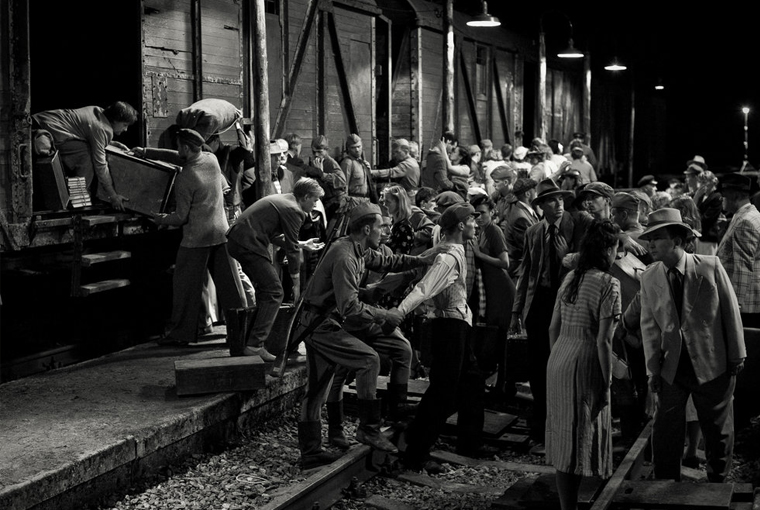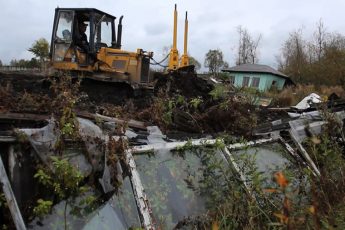A Monument for the Next Generation
Martti Helde’s In the Crosswind (Risttuules, 2016)
Vol. 68 (October 2016) by Isabelle de Pommereau
Mid-summer in idyllic Estonia. Erna Tamm, a philosophy student (Laura Peterson), Heldur (Tarmo Songand) and their daughter Eliibe (Mirt Preegel) are enjoying a few minutes of idyllic happiness, row-boating in the country side. Martti Helde’s In the Crosswind opens with mid-summer at its best.
But suddenly the screen freezes, turning black and white. The focus is on the mother and child squatted in a cattle truck, frozen in time, frozen in fear. The child clings to her mother’s legs and soldiers have their hands up as though they’re about to hit them. The stillness of the pictures magnifies the child’s terror. That terror speaks of a whole nation.
For this is 1941. As a result of a secret pact between Hitler and Stalin, the Baltic countries have lost their independence again, to Moscow. Hitler’s final solution is getting through to the public, and now Joseph Stalin is engaging in a regime of terror. That year some 60,000 Estonians are killed or deported to Siberian labor camps, along with 45,000 Lithuanians and 35,000 Latvians.
In the Crosswind is the story of the 1941 deportations told through the eyes of a young mother uprooted from her home, and from the husband she will never see again. The young philosophy student’s life ends the day that she is taken to Siberia. That day, life in Estonia ends, too. It is to convey this sense of doom that twentysomething Martti Helde chose to break cinema conventions. Far from a conventional feature film, In the Crosswind is a series of 14 black-and-white episodes. Each narrates an important milestone in the young mother’s journey, from her physical and psychological abuse to the death of her child and her rape by the chairman of a Soviet kolkhoz. In those bleak tableaux vivants, the actors stand motionless, frozen in time while the camera weaves through them, making them, and us, prisoners of the moments’ atrocity. There is no dialogue, no voice-over, only Erna, the mother, reading from her diary, which is one long monologue with her absent husband.
The world has noticed. Since its Estonian release in March 2014 and its world premiere at the Toronto Film Festival that year, In the Crosswind has reaped more than a dozen awards; moving beyond the world of art-house festivals, it was shown in movie theaters in France, too. “For us, it is a stunning film because of the topic but also the visual language it uses,” says Edith Sepp, director of the Estonian National Film Institute in Tallinn.
No topic continues to haunt the Estonian national psyche more than the Soviet deportations. Every family of today was affected, in one way or another, by what Helde calls the “Soviet Holocaust.” Indeed, Helde and others say the word “deportation” isn’t strong enough to describe a phenomenon where “men were deported, some of whom were shot on the spot, or driven in cattle cars.” Hitler’s Wehrmacht stopped that wave of terror when it entered Estonia, Latvia and Lithuania, but only to start a new chapter of atrocities: 221,000 Jews in the region were killed. In September 1944, Soviet forces swept back through the region and resumed the deporting of Baltic people to Siberia or elsewhere. Between 1944 and 1949, 400,000 Estonians, Latvians and Lithuanians were deported to Siberia.
Breaking new ground
If the five-decade-long Soviet occupation still weighs heavily in the Estonian psyche, the deportations of 1941 and 1949 were its most haunting experiences. And yet, for decades the topic found little place in the Estonian film scene. It wasn’t until 1989, when state-owned “Tallinnfilm” produced Awakening (Äratus) by director Kaljo Kiisk, that the topic was shown on screen. In the Crosswind is the first independent feature film telling the story of the Soviet deportations, and the first to deal with the first wave of deportations, the one taking place in 1941. (Awakening focused on the 1949 deportations.)
“Historically it is an important issue to deal with,” says Edith Sepp. “Martti Helde showed how deportation affected the little people – a woman for instance. What is it like for a woman to lose her child?” “He made the story personal, but he also made it a story of crime,” she said. The Soviet Union is long gone. But the film strikes a chord today, a year and a half after Russia’s annexation of Crimea rekindled old fears of the big Russian neighbor.
If, after regaining its independence in 1989, Estonia spent so much energy turning toward the West, by joining the EU, NATO and the Eurozone, it was the tiny country’s way to get away from Russia, and safeguard its hard-fought independence. But fears of losing its independence, and its identity, have lingered on. In the Crosswind put the topic of the Soviet trauma back into the Estonian national conscience just when Vladimir Putin was flexing his muscles in neighboring Ukraine.
A personal journey, not a political film
“Martti Helde’s film stands out as a film of a new generation,” says Estonian filmmaker Ilmar Raag, who was the CEO of Estonian Television in the 2000s. The film filled a void. Five decades long, during the Soviet occupation, talking about the deportations was a taboo. With the opening that Perestroika and Glasnost brought about in the 1980s, books and documentaries on Soviet atrocities started coming out. But after Estonia had regained its independence in 1991, the Estonian film industry was too poor and busy reinventing itself for any big films to be made. Although Estonia started commemorating the days of deportations as national holidays, Ilmar Raag says there was a “danger that this human tragedy was becoming just a facade for the state’s official narratives.”
It is telling that, since In the Crosswind came out, a series of films dealing with the traumatic Soviet experience have sprouted across the Baltic nations. Witness, for example, last year’s The Invisible Front, a documentary directed by Lithuanian Jonas Ohman and Vincas Sruoginis about anti-Soviet partisan leader Juozas Lukša. Or The Chronicles of Melanie, where Latvian director Viestur Kairiss focuses on the Stalinist deportations from Latvia. And Estonia had, of course, 1944, Elmo Nuganen’s box office success.
Martti Helde says he hopes his film will make people “understand what’s going on in Crimea.” But that it was released just as Moscow was moving into Crimea is but an accident, a coincidence.
In the Crosswind isn’t a reaction to a political crisis. It’s more an attempt by a budding filmmaker to come to terms with a painful history before it is too late. The idea was born out of a contest. Back in 2010, the Estonian Film Institute and Estonian Public Broadcasting solicited entries for the best historical film on the 1941 Soviet deportations. It was to be part of a 70-year retrospective.
Helde won the contest with a 50-minute documentary that would be the basis for In the Crosswind. Helde then was a graduate student at Tallinn University’s Baltic Film and Media School, and the topic drew him like a magnet. Soviet deportations had been both close and far from his life. After fighting in World War Two, where he lost a leg, his grand father had been sent to prison in Siberia. He’d come back to become a priest, and young Helde had grown up hearing his grand father’s stories. But many pieces were missing. To make sense of a painful chapter of history, he would piece the story together in a film. The topic, he said, “has shaped who we are as Estonians.”
“I was lucky to hear the story of my grandfather, but my children won’t have that connection,” Martti Helde says. “I wanted to make a monument for the next generation.”
To research his project, he delved into personal letters and diaries which he got from his family, and from national archives. And he made one discovery that would inspire him to use the black-and-white tableaux vivants. One day he stumbled upon the diary of one young mother and philosophy student who had been deported to Siberia. In her writing, she recounted the story of her life in Siberia, including the psychological and physical abuse she had undergone. In her diary, she spoke with a husband she’d never see again. “In one letter she said: ‘I felt that the time has stopped. When they took us to Siberia I felt my body has come here but my soul is still in my homeland,’” says Helde, in his studio in Tallinn. How could a woman fighting for her life write in such clear sentences? Writing had been the woman’s survival tool. How could he convey that in cinema form?
“This woman felt that in Siberia time had stopped, and I wanted to recreate the feeling, to make the audience feel they can’t move either,” he says. This was the moment Helde knew he would break with cinematographic conventions. His film would consist of still black and white images. The only voices would be that of the woman reading her diary, talking to her husband. “I wanted her voice to sink into us,” says Helde. “That was the only way for the story to reach the audience.” His documentary won first place. When he showed it at the Thessaloniki documentary film festival, the jury suggested he make a full-length figure out of it. “From day one we knew we wanted to make the film in such a form.”
The 14 still images making up In The Crosswind were painstakingly choreographed. Each one required two to six month preparation culminating in one day of shooting. There were children and older people who had to stay awake entire days. “Demanded extremely precise preparation,” recalls Tibbo-Hudgins, the producer of the film. “We did 16 takes, usually the last take was the good one.”
The right time
Helde says that, independently from the political context, it was the right time for him to talk about the painful topic of Soviet deportations. “At the beginning of the 1990s, nobody had either the money or the guts to make it, people thought it was too early,” says Helde. “People were scared of the topic, it was too difficult.
“That fifty year gap was really hard for those who were the victims who came back.” In The Crosswind, he says, has been a “kind of a relief for those who are still alive.” Helde says. “I’ve received so many thank you letters because they were waiting for someone to make a film or tell the story about it.”
“For the older generation of filmmakers it was a heavy topic. But I wasn’t so closely attached to the topic anymore. There is one generation between the event and myself.”
Still there are some in Estonia, especially among the country’s large Russian speaking community, who do not see the film with a favorable eye. Estonian writer Andrei Hvostov for example says In the Crosswind is on par with “Estonia’s fixation on its sufferings.” He says that the new films on the Soviet deportation are the result of a “competition among East-European nations on who of us has been the greatest victim in history. The Jews have the Holocaust, the Armenians the genocide and we, Estonians, we have our deportations,” he says. “I hate all this lamentation on our difficult traumatic history. It is useless: you can’t build something positive on it.”
In response to whether there is too much “fixation” on the sufferings caused by Russians, Tiina Lokk, director of the Black Nights Film Festival, says she understands the frustration of Russian speakers, especially those who have nothing to do with the history. “Each nationality has its own history and stories that need to be told… Unfortunately there are lot of painful moments in our history that are connected to Russians. If you would like to move on, you have to clean your past. It’s important not to forget about the past so you can avoid repeating history.”
Estonia has another film on the Soviet deportations in the works. It is called Comrade Child. Directed by Moonika Siimets, and based on Leelo Tungal’s autobiographical books, Grownups and Velvet and Sawdust, Comrade Child is scheduled to be released in February 2018. The film takes place in the early 1950s, when Stalinist terror is still in full swing. A mother is deported to Siberia. But this time, the story is told through the eyes of the mother’s six-year-old daughter, Leelo, who sees her mother being arrested. Leelo feels it’s her fault. Maybe she wasn’t a good enough child.
“It is an absolutely new way of telling the story of Soviet deportations,” says Piret Tibbo-Hudgins, head of productions for the Estonian Film Institute. “The child’s point of view makes everything totally absurd, and funny.”
Not everything has been told. “There are lots of interesting ways to tell the story.”




Leave a Comment